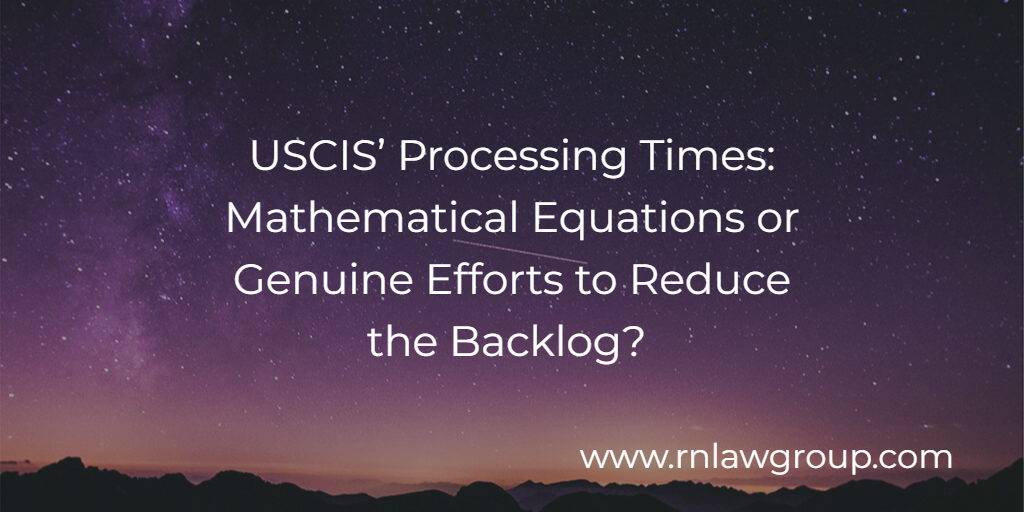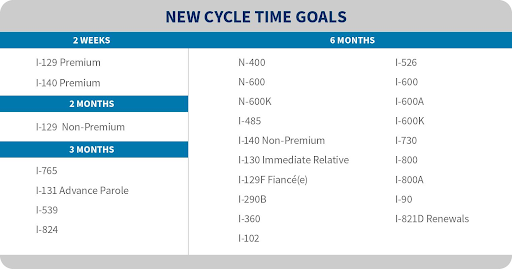
USCIS’ Processing Times: Mathematical Equations or Genuine Efforts to Reduce the Backlog?
On March 29, 2022 USCIS announced a trio of efforts to increase their efficiency and reduce the very publicized green card backlog. One of these efforts includes new agency-wide backlog reduction goals pictured here:
At first glance, the improvements seem ambitious and hopeful…until you read the fine print. USCIS’ new reduction methods are the Service’s working shift to move forms that use the cycle time methodology to the processing time methodology. What does this mean for you? Under the current processing system USCIS’ processing times posted on their website are based on 2 separate methodologies: Cycle Time and Processing Time. USCIS has utilized the cycle time methodology to measure average processing times since 2009. In 2018 USCIS implemented the use of actual case record information to provide more accurate to applicants on their website. Currently, USCIS reports that:
We use the cycle time methodology for Forms:
- I-129
- I-129CW
- I-129F
- I-130
- I-212
- I-360
- I-600
- I-600A
- I-601
- I-601A
- I-612
- I-730
- I-800
- I-800A
- I-821
- I-918
- I-929
- N-565
We use the processing time methodology for Forms:
- I-90
- I-102
- I-131
- I-140
- I-407
- I-485
- I-526
- I-539
- I-751
- I-765
- I-765V
- I-817
- I-821D
- I-824
- I-829
- I-914
- I-924
- N-400
- N-600
- N-600K
Again, what does this mean for your application(s)?
Under the Cycle Time Methodology USCIS takes the number of previous months of receipts number of previous months of receipts it takes to equal the current month’s pending receipt volume. USCIS’ hypothetical sample calculation reflects that if form I-129 has 500 applications pending for the month of March and received 200 receipts in January and 300 receipts in February, then the cycle time for Form I-129 in March is 2 months (200+300=500 pending applications). This is then defined as the lower range value. The upper range value is normally the lower range value x 1.3. If the cycle time is 2 months, then the upper range value would be 2 months x 1.3=2.6 months which USCIS would round up to 3 months.
So the range for Form I-129 processing for the month of March in this example would be 2 months to 3 months. This also means that the times listed on their website regarding your application are based on how long it took the Service to process applications, in some cases, before your application was even received.
Processing Time Methodology on the other hand calculates the number of months that elapse between the date USCIS received an application, petition, or request and the date that USCIS completes the application, petition, or request (when USCIS issues and approval or denial). USCIS provides a hypothetical example that if the Service received a Form I-485 application on February 23, 2020 and completed the application on April 5, 2020, then the processing time for that specific application is 41 days. The Service makes this calculation for every Form I-485 application that it completes in a specific period (in USCIS’ example here, this would be April 2020). USCIS then calculates the median value (or 50th percentile) for all Form I-485 applications completed from November 2019 to April 2020 inclusive, which represents the lower range value. USCIS also calculates the 93rd percentile, which represents the upper range value (or the “Receipt date for a case inquiry”). For example, for April 2020 for Form I-485, the Service’s processing times ranged from 19.5 months to 26.5 months. This means that USCIS adjudicated half its cases in 19.5 months or less (the 50% mark) and 93% of the applications in under 26.5 months. USCIS then completed the remaining 7% over 26.5 months.
In this example, the hypothetical range that would be posted on the website for Form I-485 for April 2020 would be 19.5 Months to 26.5 Months. In other words, while it may only take, for example, 41 days to adjudicate an application, it may be 17 to 22 months before that application reaches an officer’s hands.
USCIS’ goal, according to the announcement and additional information available on their processing times info page is to move forms that use the cycle time methodology to the processing time methodology because it provides the most precise and up-to-date information because the data is based on recently completed cases whereas cycle time is an estimate based on older data.
USCIS claims that its goal is to increase capacity, improve technology, and expand staffing to achieve these new goals by the end of Fiscal Year 2023. The chart above does appear to shorten the current wait times regarding application processing times but it fails to address how this will be implemented across all adjudication centers (which tend to have vastly different processing times and varied backlogs). While these new changers are encouraging, the issue remains that while the data USCIS can provide to applicants may become more accurate it does not appear that it will impact the wait time for adjudication of applications in the near future.
If you need to check your processing times they can be found at this link: https://egov.uscis.gov/processing-times/
By: Juanita Deaver
Juanita Deaver is a Staff Attorney in the I-140 and AOS Department, where she assists clients in the middle and later stages of the green card process.
Juanita earned her J.D. from South Texas College of Law Houston in May 2021. As a law-student, Juanita interned at a non-profit organization where she discovered her passion for immigration while working on family-based cases helping file I-130 petitions and I-485 adjustments of status. During her time at South Texas, she further pursued her interest in the field of immigration law through enrollment in the school’s Immigration Clinics where she worked on TPS, T visas, and DACA cases. Her experience working with families and clients in emergency situations has provided Juanita the tools and experience to provide clear and concise explanations to the seemingly daunting immigration process.
Juanita joined Reddy & Neumann as a law clerk in December 2019. While clerking, she gained valuable experience by working closely under attorneys from each of the firm’s departments on drafting successful requests for evidence, appeals, motions to re-open, and through legal research on immigration matters. Juanita understands that every case is unique and hopes to provide each client with a better understanding of the ever-changing immigration process.


